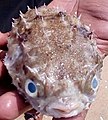Porcupinefish
| Porcupinefish Temporal range:
| |
|---|---|

| |
| Diodon nicthemerus | |
| Scientific classification | |
| Kingdom: | Animalia |
| Phylum: | Chordata |
| Class: | Actinopterygii |
| Order: | Tetraodontiformes |
| Family: | Diodontidae Bonaparte, 1838 |
| Genera[1] | |
|
Allomycterus | |
Porcupinefish are fish belonging to the family Diodontidae (order Tetraodontiformes), also commonly called blowfish and, sometimes, balloonfish and globefish. They are sometimes collectively called pufferfish,[2] not to be confused with the morphologically similar and closely related Tetraodontidae, which are more commonly given this name.
Porcupinefish are medium- to large-sized fish, and are found in shallow temperate and tropical seas worldwide. A few species are found much further out from shore, wherein large schools of thousands of individuals can occur. They are generally slow-moving.[3]
Porcupinefish have the ability to inflate their bodies by swallowing water or air, thereby becoming rounder. This increase in size (almost double vertically) reduces the range of potential predators to those with much bigger mouths. A second defense mechanism is provided by the sharp spines, which radiate outwards when the fish is inflated.
Some species are poisonous, having tetrodotoxin in their internal organs, such as the ovaries and liver. This neurotoxin is at least 1200 times more potent than cyanide. The poison is produced by several types of bacteria obtained from the fish's diet.[4] As a result of these three defenses, porcupinefish have few predators, although adults are sometimes preyed upon by sharks and killer whales. Juveniles are also preyed on by Lysiosquillina maculata, tuna, and dolphins.[3]
Porcupinefish are eaten as food fish and are an exotic delicacy in Cebu, Philippines, where they are called tagotongan.
History[]
The porcupine fish (as Diodon antennatus) is mentioned in Charles Darwin's famous account of his trip around the world, The Voyage of the Beagle. He noted how the fish can swim quite well when inflated, though the altered buoyancy requires them to do so upside down. Darwin also mentioned hearing that a fellow naturalist, Dr. Allen of Forres, had "frequently found a Diodon, floating alive and distended, in the stomach of the shark; and that on several occasions he has known it eat its way, not only through the coats of the stomach, but through the sides of the monster".[5]
Gallery[]

A porcupinefish in an aquarium

A dead porcupinefish with clearly visible spines on the shore

Preserved porcupine fish in a laboratory

A dead porcupinefish washed up on a beach

A dead porcupinefish
(video) Diodon nicthemerus swimming
In popular culture[]
A Pufferfish named Mrs. Puff, voiced by Mary Jo Catlett, appears in the animated Television Series Spongebob Squarepants, as the title character's boating (driving) instructor.
A Pufferfish named Bloat was voiced by Brad Garrett. He appeared in the 2003 Disney/Pixar animated film Finding Nemo and the 2016 sequel Finding Dory.
See also[]
References[]
- ^ Matsuura, K. (2014): Taxonomy and systematics of tetraodontiform fishes: a review focusing primarily on progress in the period from 1980 to 2014. Ichthyological Research, 62 (1): 72-113.
- ^ Mills, D. (1993). Cooke, J. (ed.). Aquarium Fish. San Diego: Dorling Kindersley. pp. 281. ISBN 1-56458-293-0.
- ^ a b Matsuura, K. & Tyler, J.C. (1998). Paxton, J.R. & Eschmeyer, W.N. (eds.). Encyclopedia of Fishes. San Diego: Academic Press. p. 231. ISBN 0-12-547665-5.
- ^ Piper, R. (2007), Extraordinary Animals: An Encyclopedia of Curious and Unusual Animals, Greenwood Press.
- ^ Darwin, Charles (1845). Journal of Researches Into the Natural History and Geology of the Countries Visited During the Voyage of H.M.S. Beagle Round the World: Under the Command of Capt. Fitz Roy. J. Murray. p. 14.
External links[]
 Media related to Diodontidae at Wikimedia Commons
Media related to Diodontidae at Wikimedia Commons Data related to Diodontidae at Wikispecies
Data related to Diodontidae at Wikispecies
- Diodontidae
- Taxa named by Charles Lucien Bonaparte





